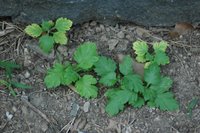But it’s not something I expected, or needed, to keep “secret.” The links, however indirect, are available (again, intentionally) for anyone who wants to pursue them. In this instance, Kati’s curiosity was piqued by my feedback about a formatting problem on her blog which prevented me from reading
her profile:
[Xris] who writes about gardening at the Flatbush Gardener blog, kindly pointed out that what I set up on my computer, may not look the same on your computer — hopefully I have fixed that problem! So I had to satisfy my curiosity as to who [Xris] was, of course, and visited his very interesting and informative blog. It seems many of his concerns are similar to mine, particularly as to how we can live (and garden) without making too much of a detrimental impact on the natural world around us. I was also very interested in [Xris’] website. …
… which led her to my real name. I’m also naturally curious about the other gardening bloggers (blogging gardeners?) I read. Especially so when non-garden interests and information “leak” into the garden space. The Web in general, and blogging in particular, has a huge capacity for supporting dissociation and fragmentation of our lives, both in viewing and publishing. I’ve noticed several people whose gardening blogs I read, such as Kati, have multiple blogs.
I’ve been tempted to do the same. There are risks and benefits to both mono-blogging and multi-blogging. One risk of mono-blogging is turning off readers who don’t ascribe to the sentiment of some “off-topic” post.
I recently unsubscribed to an upstate New York gardener’s blog when she posted for July 4 with, to my sensibilities, a most vile graphic which combined the images of a waving U.S. flag, two children (white, naturally) gazing vaguely heavenward (or looking up to “Big Daddy”), and the text “God Bless America” emblazoned across the bottom. I just don’t have the stomache for soft-core nationalist pornography when I just want to see pictures of pretty flowers.
On the other hand, a risk of multi-blogging – or of cropping the mono-blog a little too close to the stem – is missing opportunities for delineating the deep connections, subtle or glaring, among the multiple dimensions of our lives. I’ve organized my blogrolls by topic, but some blogs challenge that linear, left-brain approach.
Looking at my own blog entries, would I categorize my blog as gardening, nature or science? The division is often artificial, and purely for my convenience. Then there are the more personal connections, the real reasons why we (I) garden, and perhaps why we (I) blog.
I’ve written about, or hinted at, some of my reasons
here,
here, and
here in this blog. I could list an arm’s length of descriptive attributes about myself in my profile which have little (but not nothing) to do with my gardening.
Gardening is a source of healing for me. Does it inform the reader, or distract, to know something about the journey of recovery which comprises most of my adult life, or the lifetime of emotional darkness which preceded it?
Gardening is a deeply spiritual act for me. Does the reader understand this, or me, better to know that I’m also an atheist?
For now, I’m choosing to continue to keep this blog pruned in a naturalistic style, not sheared to crispy geometry. My gardening does connect me to larger considerations, such as invasive species, biodiversity, global warming … so I will continue to write about those things here, alongside the photos of the bugs and flowers under my care.
I believe we must all become – we already are – gardeners of the world. I will act, and write, “as if” my work and words matter. It is my hope that the seeds I plant, the weeds I take, the feelings and thoughts I express, help to heal the world.



